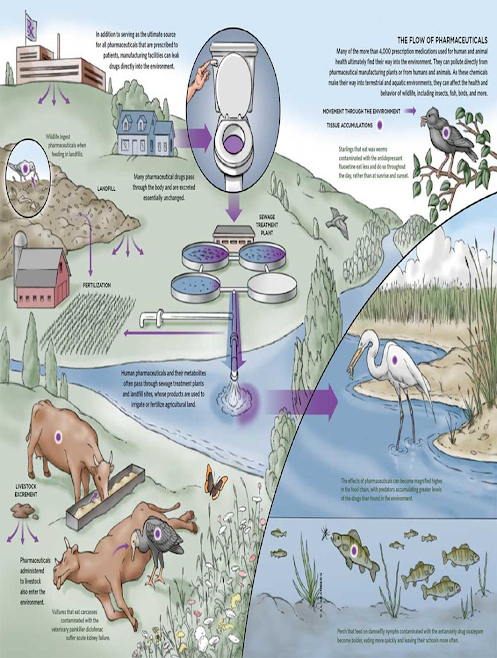Posts
Pharmaceuticals in Water
- Get link
- X
- Other Apps

There is a growing concern about the occurrence of pharmaceuticals in water bodies and in drinking water. Pharmaceuticals get into the water supply via human excretion and by drugs being flushed down the toilet. You might think wastewater treatment plants would take care of the situation, but pharmaceuticals pass through water treatment. Pharmaceuticals in Water Source of pharmaceuticals in streams In a 2004 to 2009 U.S. Geological Survey (USGS) study, scientists found that pharmaceutical manufacturing facilities can be a significant source of pharmaceuticals to the environment. Effluents from two wastewater treatment plants (WWTPs) that receive discharge from pharmaceutical manufacturing facilities (PMFs) had 10 to 1,000 times higher concentrations of pharmaceuticals than effluents from 24 WWTPs across the nation that do not receive PMF discharge. The release waters from these two WWTPs were discharged to streams where the measured pharmaceuticals were tr...
A Simple Breakdown of PFAS the Forever Chemicals
- Get link
- X
- Other Apps
With much talk going on about PFAS, there seems to be too much technical information and not enough down-to-earth explanations on exactly what these are. In this article, I will break down what PFAS are, what they are known to do to us, where they come from, where they can be found and how you can keep your family safe from these chemicals. PFAS or Per-and Polyfluoroalkyl Substances are a group of manufactured chemicals that have been used in industry and consumer products since the 1940s. There are literally thousands of different PFAS and are known to cause reproductive effects such as decreased fertility. They are responsible for increased high blood pressure in pregnant women and have developmental effects or delays in children. PFAS is also attributed to increased risk of some cancers like prostate, kidney, and testicular. Studies have also shown that PFAS reduce the ability of the body’s immune system and create a reduced vaccine response. There can be interference with t...
What is Water? Where Does Water Come From?
- Get link
- X
- Other Apps
Water We all know water is a molecule called H2O that contains two atoms of hydrogen and one atom of oxygen. Its a transparent, odorless, tasteless liquid. (Now water that has a bad taste and a unpleasant odor means there are other element's such as iron, ferrous or ferric/sulfur and possible bacteria.) We find water in lakes, streams, creeks, rivers and oceans. The hydrologic cycle is the process of water from the above motioned is gathered as water vapor (Suns heat causes surface water to evaporate) and returned to the earth in the form of snow and rain. Ground Water to Drinking Water: From the highways to the city streets, country roads, neighborhood streets, parking lots and city dumps / land fills the water we use washes away and collects all the dirt, grim, grease, gas, diesel fuel, animal waste, discarded cigarettes, human waste, Industrial waste etc etc.. All of this is added to the water resources we use to draw our water supply. ...
Bacteria Resistant To Last Resort Antibiotic Found For First Time In Los Angeles County Wastewater
- Get link
- X
- Other Apps
Bacteria that renders colistin, a “last resort” antibiotic, ineffective are lurking in SoCal’s wastewater. While bacteria resistant to colistin have been found elsewhere in the world, this marks the first detection in Los Angeles wastewater. The bacteria and associated genes that provide resistance to colistin were discovered at the county’s two largest wastewater plants. One treatment center serves 4 million residents, the other serves 3.5 million. The resistant bacteria and associated genes were discovered by Adam Smith, a professor in the Sonny Astani Department of Civil and Environmental Engineering, and documented in a new paper published in Environmental Science & Technology Letters. Smith, who documented COVID’s presence in wastewater during the pandemic, admits this type of antibiotic resistant gene has been found elsewhere in the world (6 of 7 continents, he said) but this is first time there are traces of this particular antibiotic resistance in LA. Smith says that ...
"EPA" PFAS Drinking Water Treatment Technologies
- Get link
- X
- Other Apps
Below is from a webinar offered by the EPA. "EPA evaluated technologies and has studies that demonstrate effective removal of all regulated PFAS. EPA has identified the following as best available technologies." Granular Activated Carbon (GAC) Anion Exchange (AIX) Nanofiltration (NF) and Reverse Osmosis (RO) The above three are great for point of use, but not for point of distribution. So back to my earlier blog. Why would the EPA recommend solutions that would be ideal for an individual home, but just about impossible for a large municipal water district to achieve. So what do we do? The recommended technology is ideal for individual homes. Taking control of the responsibility of our own water quality is the best way to ensure the quality of our water. Some one told me and it makes sense, "if your water is not organic, then you are defeating the purpose."